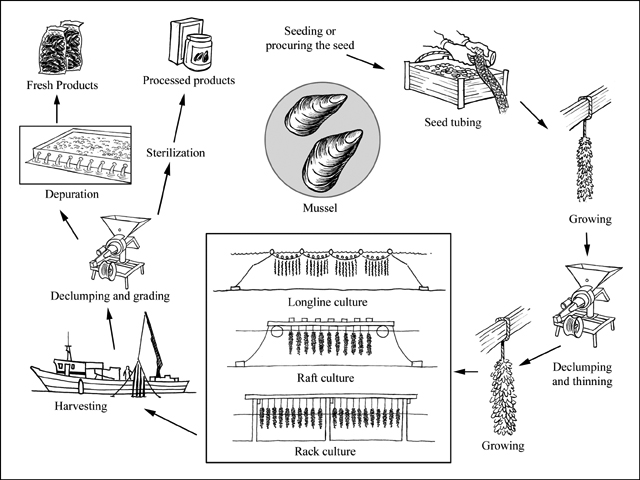1) What are the most important characteristics of the mussel?
2) What is the best time for the consumption of fresh mussels?
3) Where are mussels cultivated?
4) How are mussels cultivated?
5) What are the "red tides"?
6) What is the control of bio-toxins?
What are the most important characteristics of the mussel?
The Mussel (Mytilus galloprovincialis) is a bivalve mollusc whose shell is composed
of two valves symmetrical, elongated and triangular, calcium carbonate, covered
externally by a layer of bluish colour. In its shell can be observed a few concentric
lines called striations of growth, which is observed, as it has been occurring growth.
Feeds filtering particles of matter in suspension and phytoplankton found in water
so its growth is subject to the availability of these. The gills are highly developed,
and are used both for breathing and feeding. It is a large filter feeder; under normal
conditions a medium-sized Mussel filters out 4 to 5 litres of water at the time, being
able to efficiently capture particles with diameters between 2-5 microns. A string of
Mussel can filter more than 700,000 litres of water in a day and a "batea" (production
raft) can consume 180 metric tons of organic matter in a year.
Differentiation by gender of the mussels can be observed at a glance once cooked by
their colour: darker in colour, orange or reddish parts are females and the paler are
males, although these tones may be more or less accused on the basis of the diet that
provides the mussel in the marine environment. Lorbé Mussel is characterized by being
clearer than in other areas for this reason. [return]
What is the best time for the consumption of fresh mussels?
Due to the particular conditions of its cultivation and food, the time in which the
mussel begins to find itself in an optimal state is from the months of June / July
because, starting in the spring, there is availability of food in the water. These
optimal conditions are extended during the second half of the year and even during
the first months of the following year while the harvest is not exhausted. The end
of winter and early spring is the worst time to eat fresh mussels.
Production of frozen mussels, in brine or pasteurized, allows the consumption of
mussels in their prime all year round the year. [return]
Where are mussels cultivated?
The Galician estuaries are optimal zones for cultivation due to its special geographic
and oceanographic conditions. The main reason for being an ecosystem with as high
productivity is the outcrop: ascent to the surface of cold water from deep areas
that drag a lot of nutrients. Harnessing this potential of the estuaries enables
a shorter time period for growth than in other places.
There are approximately 3,400 production rafts across the estuaries of Ares - Betanzos,
Muros, Arosa, Pontevedra and Vigo in Galicia. There is an anecdotal presence in Balyona
y Corme. This crop production is a strategic sector of great importance in the Galician
economy and diet. [return]
How are mussels cultivated?
It is traditionally grown in floating rafts called "bateas" which consist of a
gridiron of eucalyptus wood which are mounted on floats of iron coated polyester and
fiberglass. A maximum of 500 ropes of 12 meters in length, in which the mussel is
held by its byssus (filament to fix to rocks, ropes or almost any substrate) can hang
this artefact. These rafts are placed within the polygons of cultivation in previously
determined positions in the interior of the estuaries.
The mussel cultivation cycle begins with the harvesting of breeding or seed in the
rocks or collectors placed strategically and prior to fixing this breeding, which
has some early stages of its life in water (pelagic stages) free. It is planted in
the initial string with the help of surround gauze that holds the mussel till it
secretes the byssus, which is going to fix it to the rope. After approximately 6 months
it is a split of the initial string into two or three new strings to reduce the density
and allow the growth to continue. Finally and after about 12 months time it is ready
for commercialization.

Production cycle of Mytilus galloprovincialis. Source: FAO
[return]
What are the "red tides"?
At certain times of the year the mussel is susceptible to an accumulation of certain
substances called "bio-toxins", containing some species of phytoplankton that feeds,
and they are known as "red tides". In case of high concentrations of these species
of phytoplankton in the water, to be part of the diet of mussels, it can accumulate
these substances giving rise to toxicity if consumed, although it does not cause damage
to the mussel.
There are currently systems established by the Administration and executed by them and
also by companies to ensure the safety of these products, as far as marketing is carried
out through the legal channels. Galicia is a world reference in the control of the
bio-toxins because of the structure that has been developed. [return]
What is the control of bio-toxins?
Local Galician Government exercises an initial monitoring in three aspects differentiated
as preventive measures. In a first step, controls the oceanographic conditions to know
when there are the best ones for the development of plankton species that may contain
bio-toxins. A second part of the control consists of the investigation of the presence
in water of these potentially toxic species of plankton. The third part, which is the
final for toxicity data, consists of the analysis of Mussel.
Marketing companies, as responsible for products placed on the market, have at their
disposal and use the information generated by the Administration and also conduct their
own analytical controls to ensure the wholesomeness of their products.
Depending on the risk, companies and Administration perform the analysis with greater
or lesser frequencies. [return]